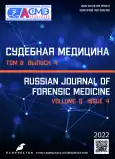Клинические и морфологические особенности злокачественной гипертермии: редкий случай из практики
- Авторы: Аничков Н.М.1, Калинина Е.Ю.1, Давыдова З.В.1, Щербакова Е.В.2, Ягмуров О.Д.3
-
Учреждения:
- Санкт-Петербургский государственный педиатрический медицинский университет
- Бюро судебно-медицинской экспертизы Ленинградской области
- Санкт-Петербургское бюро судебно-медицинской экспертизы
- Выпуск: Том 8, № 4 (2022)
- Страницы: 97-104
- Раздел: Экспертная практика
- URL: https://journals.rcsi.science/2411-8729/article/view/122482
- DOI: https://doi.org/10.17816/fm733
- ID: 122482
Цитировать
Полный текст
Аннотация
Одним из наиболее тяжёлых осложнений современной общей анестезии является злокачественная гипертермия, фенотипически проявляющаяся гиперкапнией, синусовой тахикардией, гиперметаболизмом скелетных мышц и рабдомиолизом во время или после проведения общей анестезии с применением ингаляционных анестетиков и недеполяризующих мышечных релаксантов. Наиболее частым начальным признаком злокачественной гипертермии является неожиданный подъём концентрации CO2 в конце выдоха. Атипичные формы данного фармакогенетического заболевания наблюдаются намного чаще, чем молниеносные (фульминантные). В России проблема злокачественной гипертермии в настоящее время остаётся не до конца решённой.
Авторами описывается случай злокачественной гипертермии у девушки 19 лет, прооперированной по поводу нарушения носового дыхания в условиях анестезии севораном. Смерть пациентки наступила через 1 ч 25 мин после окончания операции при выходе из наркоза вследствие развития клинически диагностированной злокачественной гипертермии. При судебно-медицинском вскрытии данный диагноз был подтверждён. Приводится описание морфологических изменений в скелетной мускулатуре с применением как обзорной, так и элективной гистологической окраски.
Ценность представленного наблюдения обусловлена редкостью молниеносных форм злокачественной гипертермии и высокой летальностью, сопровождающих указанные варианты патологии. Материалы данного экспертного случая демонстрируют, как грамотно и полноценно проведённое гистологическое исследование, в том числе с применением генетического тестирования, позволяет верно сформулировать диагноз и в случае необходимости аргументированно ответить на вопросы правоохранительных органов.
Ключевые слова
Полный текст
Открыть статью на сайте журналаОб авторах
Николай Мильевич Аничков
Санкт-Петербургский государственный педиатрический медицинский университет
Email: anichkov@bk.ru
ORCID iD: 0000-0003-1834-7881
SPIN-код: 5222-7003
д.м.н., профессор
Россия, 194100, Санкт-Петербург, ул. Литовская, д. 2Елена Юрьевна Калинина
Санкт-Петербургский государственный педиатрический медицинский университет
Email: drkalinina@yandex.ru
ORCID iD: 0000-0001-7077-3584
SPIN-код: 1176-5739
к.м.н.
Россия, 194100, Санкт-Петербург, ул. Литовская, д. 2Злата Вячеславовна Давыдова
Санкт-Петербургский государственный педиатрический медицинский университет
Автор, ответственный за переписку.
Email: zlata.davydova@rambler.ru
ORCID iD: 0000-0002-6673-8230
SPIN-код: 7016-7086
к.м.н.
Россия, 194100, Санкт-Петербург, ул. Литовская, д. 2Екатерина Васильевна Щербакова
Бюро судебно-медицинской экспертизы Ленинградской области
Email: maestrovody@mail.ru
ORCID iD: 0000-0002-3818-1535
SPIN-код: 7685-0130
Россия, Санкт-Петербург
Ораз Джумаевич Ягмуров
Санкт-Петербургское бюро судебно-медицинской экспертизы
Email: oraz.yagmurov@gmail.com
ORCID iD: 0000-0003-1822-6043
SPIN-код: 7765-8978
д.м.н.
Россия, Санкт-ПетербургСписок литературы
- Lawal T.A., Wires E.S., Terry N.L., et al. Preclinical model systems of ryanodine receptor 1-related myopathies and malignant hyperthermia: a comprehensive scoping review of works published 1990–2019 // Orphanet J Rare Dis. 2020. Vol. 15, N 1. Р. 113. doi: 10.1186/s13023-020-01384-x
- Gong X. Malignant hyperthermia when dantrolene is not readily available // BMC Anesthesiol. 2021. Vol. 21, N 1. Р. 119. doi: 10.1186/s12871-021-01328-3
- Yang L., Tautz T., Zhang S., et al. The current status of malignant hyperthermia // J Biomed Res. 2020. Vol. 34, N 2. Р. 75–85. doi: 10.7555/JBR.33.20180089
- Knuiman G.J., Küsters B., Eshuis L., et al. The histopathological spectrum of malignant hyperthermia and rhabdomyolysis due to RYR1 mutations // J Neurol. 2019 Vol. 266, N 4. Р. 876–887. doi: 10.1007/s00415-019-09209-z
- Chang L., Daly C., Miller D.M., et al. Permeabilised skeletal muscle reveals mitochondrial deficiency in malignant hyperthermia-susceptible individuals // Br J Anaesth. 2019. Vol. 122, N 5. Р. 613–621. doi: 10.1016/j.bja.2019.02.010
- Larach M.G., Localio A.R., Allen G.C., et al. A clinical grading scale to predict malignant hyperthermia susceptibility // Anesthesiology. 1994. Vol. 80, N 4. Р. 771–779. doi: 10.1097/00000542-199404000-00008
- Lie J.T., Holley K.F., Kampa W.R., et al. New histochemical method for morphologic diagnosis of early stages of myocardial ischemia // Proc Mayo Clin. 1971. Vol. 46, N 5. Р. 319–327.
Дополнительные файлы










